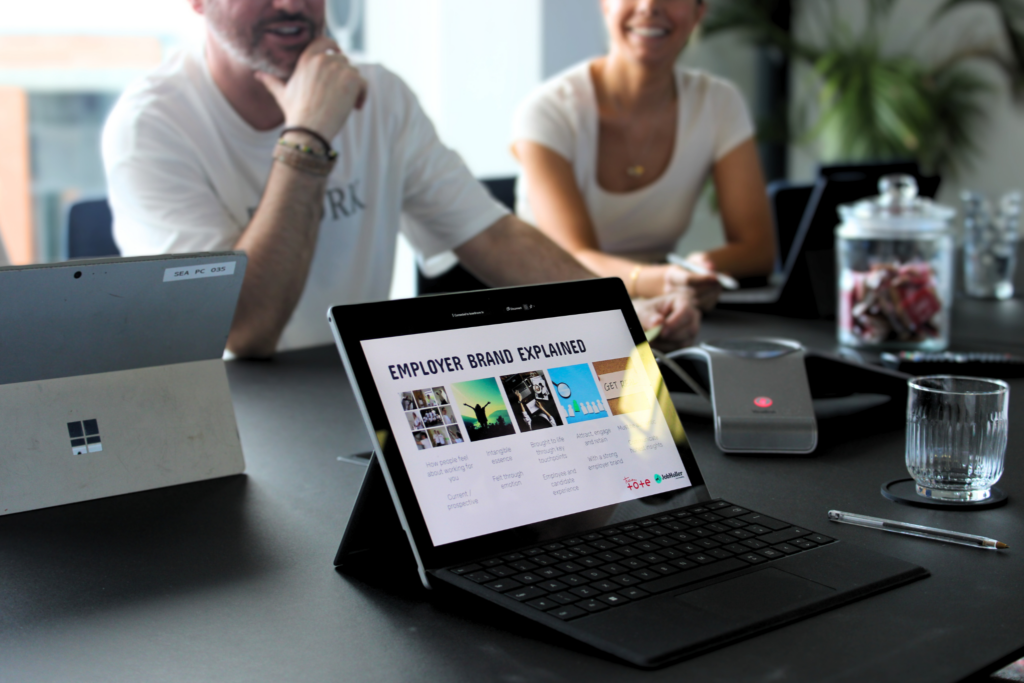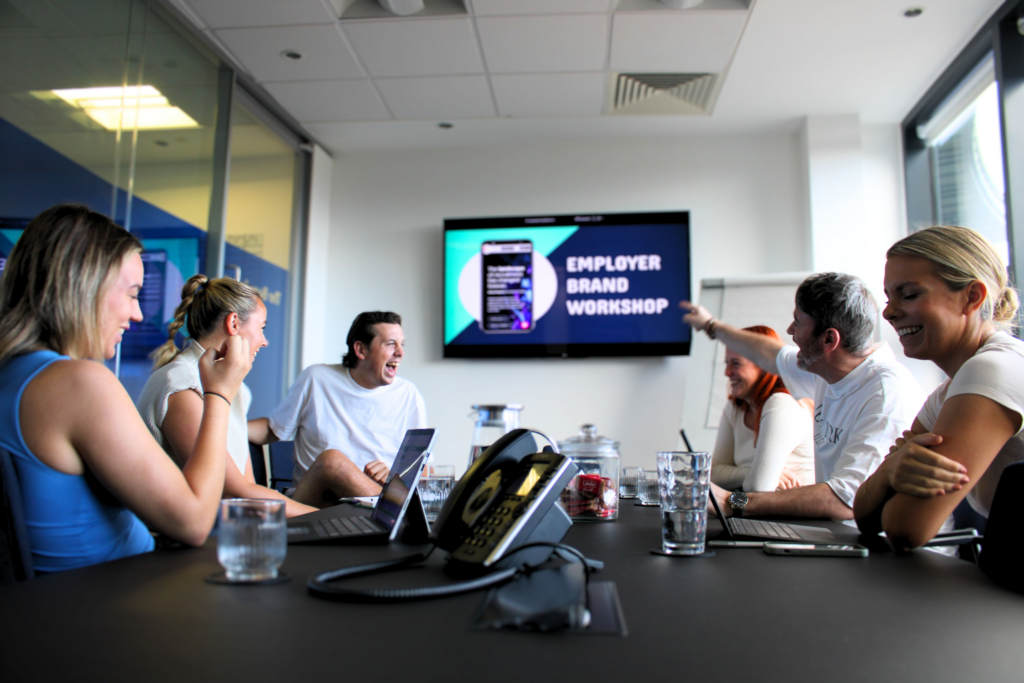Episode 7 of the Holler Pod is back! With Searchability‘s Director and Presenter Olly Preston bringing on Holler’s Director of Employer Branding and Marketing Sophie Hopley and Manager Leah Cottham. We discuss ALL things Employer Branding.
Who is Holler?
So Holler is part of the Searchability Group, I joined 2015 as a Digital Campaign Manager, initially focusing on brand marketing and our recruitment marketing.
Despite having prior marketing experience in fashion, events, and property, the recruitment sector was new to me. I stumbled into employer branding while exploring recruitment marketing strategies. At that time, promoting an employer brand online was unconventional in recruitment. To expand on this concept, I sought mentorship from Brett Minchington, a global authority on employer branding who provides a employer brand leadership course.
We leveraged this knowledge and strategic frameworks to create our technology product, JobHoller, offering account management services alongside it. Over the years, our services expanded, and we transformed into a full-service employer branding and marketing agency with a tech product at our core. This transformation is one reason for our rebrand to become Holler.
After 8.5 years with the company, my role has evolved into “Employer Brand and Marketing Director.” I oversee the Searchability marketing team and Holler. Leah, our “Employer Brand and Marketing Manager,” has also experienced significant growth during her 5 years with the Searchability Group, starting as a Graduate Researcher and now becoming an Employer Branding and Marketing Manager.
What exactly IS employer branding?
Employer branding is how your organisation is perceived as a ‘great place to work’ by current employees and external stakeholders (candidates, clients, customers). It’s about how people FEEL about working for you—an intangible essence conveyed through emotions and experienced through touchpoints in the employee and candidate journey. Every company has an employer brand, but actively managing it to attract, engage, and retain top talent is a necessity.

Importance of Employer Branding for a Recruitment Agency
Employer branding is crucial for all organisations, especially in recruitment, as it affects candidate attraction, employee engagement, retention, and advocacy. When competing for talent, you must not only attract but also retain top employees. Disengaged employees harm productivity, imagine losing top talent to competitors due to a better employer brand. Even if people leave, it’s better when they do so positively; as they may become future clients. Leaving on a bad note can harm your employer brand and future relationships.

Building your Employer Brand
So there’s obviously quite a lengthy process and strategy involved here, it’s one of the services we provide at Holler as people often don’t have the in-house capability / time / resource to do this, but to give a very quick over view of the steps involved:
Step 1 – You measure your existing employer brand presence
As we mentioned everyone already has an employer brand. So, measure your current employer brand presence online by analysing your website, social media, and feedback channels.
Step 2 – Assemble your internal employer brand team
To bring the employer brand to life and to ensure buy-in across all areas of the business you’ll want to assemble an employer brand team. Assemble an internal employer brand team, including directors, marketing, HR, department managers, and junior team members to ensure buy in.
Step 3 – Measure employee engagement
Measure employee engagement to identify strengths, weaknesses, and alignment with your employer brand vision.
Step 4 – Creating your employer value proposition (Or EVP)
So the definition of EVP is: “a set of associations and offerings provided by an organisation in return for the skills, capabilities and experiences an employee brings to the organisation.”
It doesn’t just revolve around tangible perks and benefits but takes into consideration elements like your culture, environment, and career opportunities. Often you’ll have a nice catchy tagline that communicates the EVP, backed up by well defined EVP pillars that communicate this effectively.
Step 5 – Creating an employer brand architecture and brand guidelines
Develop an employer brand architecture and brand guidelines encompassing brand essence, values, EVP tagline, pillars, themes, imagery, hashtags, and creative style.
Step 6: Showcasing the employer brand
Showcase your employer brand through visual content on your website, social media, and platforms like Glassdoor, ensuring consistency across all channels.
Promoting your Employer Brand
To effectively communicate your employer brand, focus on the message you want to convey to the outside world. Consider your objectives, such as increasing candidate attraction, and track the source of applications. Tailor your content accordingly. Leverage employee advocacy as a powerful tool to showcase your company’s culture and why it’s a great place to work.

Selecting your social media platforms
Selecting the right platform is crucial because every company is unique and can present itself differently. LinkedIn is a great choice for professional networking and employer branding, allowing you to share company news, culture, job openings, and employee stories. It’s also a platform to engage with industry-related content and connect with potential candidates. Glassdoor, primarily a review site for employees, can also be valuable for employer branding by encouraging satisfied employees to leave reviews, responding to feedback, and highlighting positive aspects of your workplace. Instagram is perfect for showcasing your company culture visually, enabling you to share behind-the-scenes photos, employee spotlights, and stories that depict your workplace environment. For short, engaging videos that creatively showcase your culture, job roles, and employee experiences, TikTok can be a dynamic platform to consider.
Considering Negativity Surrounding Feedback
Dealing with negativity is crucial. These issues may include negative feedback, bad Glassdoor reviews, negative social media posts, or employee departures. Listen to the feedback, even if management disagrees, and consider taking action where necessary to bring about positive change. Respond to feedback, especially in public forums like Glassdoor or social media, with a senior company member addressing the comments professionally and concisely. It’s an opportunity to show you’re attentive, responsive, and actively working to enhance your employer brand. Preparation is key, even if you hope not to encounter these issues frequently.
Recognition for Strong Employer Brand
You can measure employee engagement through various tools such as The Best Companies employee engagement survey, which can earn you recognition for. Another option is Industry-specific awards, s that can provide opportunities to showcase your employer brand, like winning “Best Employer Brand” (like us!).

Measuring whether your Employer Brand truly represents your organisation
Gather feedback from various sources to understand your employer brand’s perception. Utilise surveys and feedback to ask questions about company culture, values, work environment, and overall experiences to identify gaps between the brand image and reality. Candidate experience feedback, whether hired or not, can reveal the alignment between your employer brand and the actual candidate experience. Keep an eye on retention rates; a high turnover might signal a disconnect between your brand promises and the real work environment. Additionally, use social media and web analytics to monitor engagement levels on your social platforms and careers website, tracking website traffic, click-through rates, and user interactions to gauge the resonance of your content and branding with your audience. The story of BrewDog, initially championed as a “best employer”, however whistleblower employees shared about a toxic culture online, highlights the importance of aligning your employer brand with the actual workplace reality.

Emerging Trends in Employer Brand
Employer branding (EB) has seen a significant shift towards prioritising Diversity, Equity, and Inclusion (DE&I). Companies are not only emphasizing their commitment to DE&I but actively working to create inclusive workplaces and attract a diverse talent pool. Sustainability and Corporate Social Responsibility have also become crucial aspects of EB, with employers showcasing their eco-friendly practices and community involvement as integral parts of their culture. In a world where AI and technology are continuously emerging, finding a balance between technological advances and a human-centered approach is essential. Additionally, staying up to date with social media trends, such as the preference for TikTok videos over traditional Facebook posts, is vital in engaging with the modern audience. Lastly, the World EB Day conference in October serves as a platform for industry leaders to share insights and stay at the forefront of the evolving employer branding landscape.
If you are looking for assistance with Employer Brand get in touch with our Holler Team – [email protected]!



